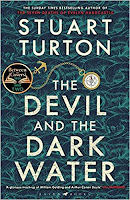I had been looking forward to read this book ever since Turton announced it, given how delightful his first book, The Seven Deaths of Evelyn Hardcastle (7 Deaths Review), was! While The Devil and the Deep Water is not as complex and jaw-dropping as his first book, it’s still a surprising story, is a page turner from the first page to the last and ends satisfyingly!
The story is set on a ship, the Sardaam, which is transporting cargo from Batavia to Amsterdam for the United East India Company. Governor General Jan Haan is the senior-most official on board and is also carrying some personal secret consignments. He is accompanied by his wife, Sara Wessels, his daughter, Lia, and his mistress Creesjie Jens – all of them accomplished women but forced to hide behind a veil of mediocrity in keeping with the times. A famous investigator, Samuel Pipps, is a prisoner on board and his journey from being a hero a short while ago to a prisoner is shrouded in mystery. Arent Hayes is his bodyguard and sidekick and in the absence of Pipps’ freedom, takes on a more central role in the proceedings.
The mysteries begin from the end of the first chapter itself. And as the story moves forward, tales of fear, greed, betrayal and revenge emerge, framed in the backdrop of a devil called Old Tom, as various characters get killed off. The “dark water” of the title could refer to the sea around the ship or could refer to the evil in the souls of men. Besides the mysteries of the various protagonists, there is a strong supernatural element through the book and after the experience with Turton’s first book, it is impossible to decide whether this element is imaginary or not.
Like all good mystery novels, this one is a page turner right until the end. And has a big surprise towards the end. And ties up all the loose ends and the questions raised through the book, neatly. There are several references to the period in which the story is based but as Turton pens in an “apology” at the end, he has sacrificed some of the historical realism to befit the narrative.
The absolute ending is perhaps a trifle glib and convenient. And this book is nowhere as jaw-dropping as his first book. But that does not take away from the fact that this is an extremely enjoyable book. I now can’t wait for his third book!
Pros: Page-turner, satisfying and surprising denouement, well-written
Cons: A trifle convenient ending perhaps


